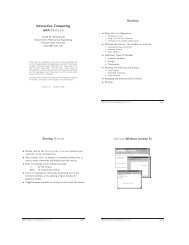PRE-LAB FOR YEAST RESPIRATION AND FERMENTATION
PRE-LAB FOR YEAST RESPIRATION AND FERMENTATION
PRE-LAB FOR YEAST RESPIRATION AND FERMENTATION
Create successful ePaper yourself
Turn your PDF publications into a flip-book with our unique Google optimized e-Paper software.
5. If you were an anaerobic organism, would you prefer to live in asealed flask or in one with aeration? Why?Why would the opposite environment be of no benefit to you?6. What is a gaseous by-product of the type of fermentation we will bedoing in this lab? __________________In champagne, what evidence is there of this gas?PROCEDURE QUESTIONS:7. There are three large flasks that will be prepared in advance. They arelabeled A, B, C. What is inside each? What preparations were made toeach one?A.______________________ B.______________________ C.______________________________________________ ________________________ ________________________________________________ ________________________ ________________________8. What temperature should you heat the culture to before turning off thehot plate? __________What temperature is too high? _____________9. Why should the temperature of the culture stay away from 90°C andabove? What happens at these temperatures?
10. Based on your vast sum of stored knowledge, which flask (A,B, or C)would you expect to give off more alcohol (as shown by gaschromatograph) ? Why? Why not for the other two flasks?Yeast Fermentation MinilabsDIRECTIONS1. Bromthymol blue, oxygen, and carbon dioxide.What causes the change in a bromthymol blue solution? Design andcarry out an experiment to determinethe color change and its cause.Materials that can be used are straws,flasks, water, yeast culture, aquariumair bubbler, weak acid solution (HCl,hydrochloric acid), and weak basesolution (sodium bicarbonate,NaHCO 3 .)2. Yeast culture and gas formation.What gas is being formed in an active yeast culture? Design anexperiment to determine the nature of the gas.Materials: (see above).3. Yeast CellsWhat do yeast cells look like and how big are they? Design anexperiment to illustrate the shape and size of yeast cells.Materials: Yeast culture, pipet, microscope, microscope slide,coverslip, various vital stains.4. Build models of organic molecules involved in Fermentation andGlycolysis. Submit the model and an accurate drawing to get credit.5. Research the question - "Why Beer is Bubbly". Write down 5 facts youlearn from this research.
Name____________________________Date______________Pre-Lab Questions: Yeast Respiration & Fermentation1. What is cellular respiration?2. What are the two stages of cellular respiration?3. What is fermentation?4. What is ATP? Why is ATP important?5. How do the products differ between respiration and fermentation?6. In which situation is air present -during respiration or fermentation?7. How many stages are there in fermentation? Which stage that is present in cellularrespiration is not present in fermentation?8. In which process, respiration or fermentation, are carbohydrates not completely brokendown? How does this affect the amount of ATP released ?9. Why is fermentation important for yeast?
10. What is gas chromatography used for?11. What does "elute" mean? What might affect elution rates?12. How can we use gas chromatography to identify substances found in a mixture?13.What is the purpose of this lab?14. What is the difference between cultures A, B, C? (We will discuss this.)15. What temperature should be maintained in order to get the best results?16. How are you going to maintain the temperature? (We will discuss.)17. What should be done when the water reaches a temperature of 70 C? Why?18.Why is it important not to let water drip from the paper towel in the collection vial?19. What is a distillate?















